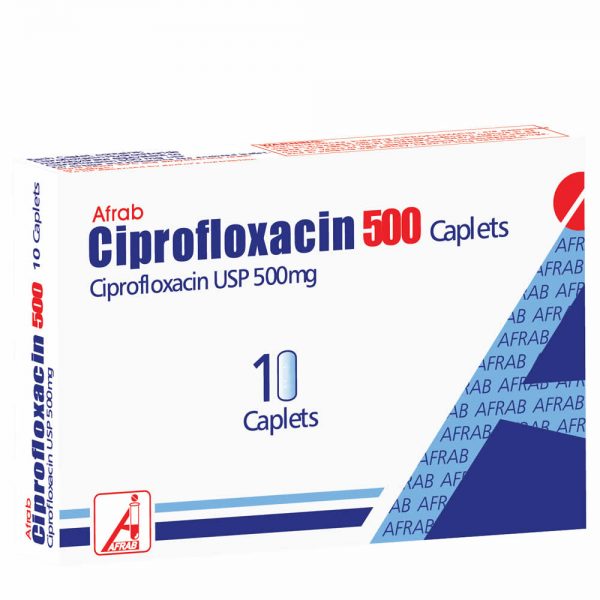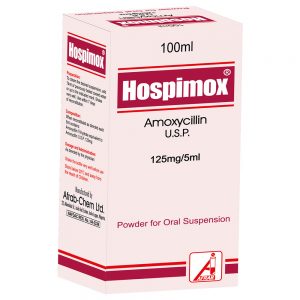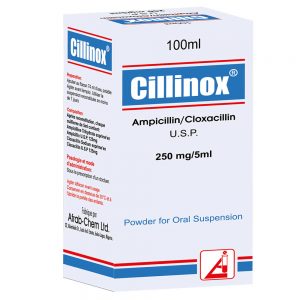- Have any questions?
- 0809 992 8864
- info@afrabchem.com
Products
Hospimox Suspension (250mg)
March 5, 2019
Aframpi
March 5, 2019Afrab Ciprofloxacin
Tablets (NRN: 04-2791): Ciplofloxacin 500 mg.
Pack size: Box of 10 blistered tablets
Therapeutic Class
Antibacterial, Quinolones
Dosage Form, Composition & NAFDAC Registration Number (NRN)
Tablets (NRN: 04-2791): Ciplofloxacin 500 mg.
Pack size: Box of 10 blistered tablets
Pharmacology
Ciprofloxacin is a bactericidal fluoroquinolone that acts intracellularly by inhibiting DNA gyrase, which is an essential bacterial enzyme and a critical catalyst in the duplication, transcription, and repair of bacterial DNA. Cipro is a broad-spectrum anti-infective, active against a wide range of aerobic gram-positive and gram-negative organisms. It is activein vitro against most Enterobacteriaceae, including Citrobacter, Enterobacter, Klebsiella, Proteus, Salmonella, Shigella, and Vibrio species and against Escherichia coli, Morganella morganii, and Yersinia entercolitica. Cipro has also good in vitro acitivity against multiple resistant gram-negative bacilli, penicillin-resistant strains of Neisseria gonorrhoeae and beta lactamase-producing strains of Haemophillus influenzae and Moraxella catarrhalis.
Cipro has the greatest activity of the fluoroquinolones in vitro against most organisms. It is the most active againstPseudomonas aeruginosa. Cipro also has good activity in vitro against Staphyloccoccus aureus including methicillin-resistant (MRSA) strains, S. saprophyticus, S. epidermidis and other Staphylococci; as well as Chlamydia trachomatis,Mycobacterium tuberculosis and atypical mycobacteria, in addition to Mycoplasma and Legionella species. Streptocococciare all moderately susceptible to Cipro in vitro.
Cipro is rapidly and well absorbed from the gastrointestinal tract with a bioavailability of approximately 70%. It is widely distributed to most body fluids and tissues, and it also penetrates the cerebrospinal fluid.
Indications
Bone and joint infections, bacterial exacerbations of bronchitis, skin and soft tissue infections, and complicated urinary tract infections, when caused by organisms susceptible to Cipro. Bacterial gastroenteritis caused by Aeromonas hydrophillia, enterotoxigenic E. coli, Salmonella species, Shigella flexneri, S. sonnei, and Vibrio parahaemoyticcus. Endocervical and urethral infections caused by Neisseria gonorrhoeae. Bacterial gram-negative and streptococcal pneumonia. Typhoid fever caused by Salmonella typhi strains susceptible to Cipro.
Cipro is also used in the treatment of bacterial prostatitis caused by susceptible organisms, and the treatment of chancroid caused by Haemophillus ducreyi.
Note: Not all species or strains of a particular organism may be susceptible to Ciprofloxacin.
Contra-indications
Hypersensitivity to the drug or to other quinolones.
Pregnancy and lactation.
Precautions/Warnings
Like other fluoroquinolones, Ciprofloxacin can cause serious hypersensitivity reactions. Patients should discontinue the drug and contact their physician at the first sign of rash or hypersensitivity.
Ciprofloxacin may cause dizziness or lightheadedness. Caution should be exercised while operating a motor or machinery.
Ciprofloxacin is not recommended in patients up to age 18, because fluoroquinolones caused lameness in immature dogs due to permanent lesions of the cartilage of weight-bearing joints and caused arthropathy in immature animals of various species.
Risk-benefit ratio should be considered when the following medical problems exist: CNS disorder including cerebral arteriosclerosis or epilepsy because, like other fluoro-quinolones, Ciprofloxacin may cause CNS stimulation or toxicity.
Ciprofloxacin is primarily excreted renally. Patients with impaired renal function requires a reduced dose of Ciprofloxacin (see “Dosage”).
Use In Pregnancy: Ciprofloxacin crosses the placenta. Adequate and well-controlled studies in humans have not been done. However, because most fluoroquinolones caused arthropathy in immature animals, Ciprofloxacin should not be used in pregnant women, FDA Pregnancy Category C.
Use In Lactation: Ciprofloxacin is distributed into human breast milk. Because fluoroquinolones have been shown to cause permanent lesions of the cartilage of weight-bearing joints, as well as other signs of arthropathy in immature animals, a decision should be made whether to discontinue nursing or the drug, taking into consideration the importance of the drug to the woman.
Interference with clinical and laboratory tests: Serum values of alanine aminotransferase, alkaline phosphates, asparate amino-transferase and lactate dehydrogenase may be increased with Ciprofloxacin therapy.
Interactions
Concurrent use of Ciprofloxacin with a Theophylline derivative may result in higher and prolonged serum theophylline concentrations and may increase the risk of theophylline related adverse effects. Serum theophylline concentrations should be monitored and dosage adjustments may be required.
Ciprofloxacin absorption may be reduced by antacids, ferrous sulfate, zinc or sucralfate resulting in lower serum and urine concentrations. Ciprofloxacin should be taken at least 2 hours before or 6 hours after any of these medications. Didanosine also reduces Ciprofloxacin absorption and should not be administered concurrently.
Ciprofloxacin reduces the hepatic metabolism and clearance of Caffeine, thus increasing its half-life and the risk of caffeine-related CNS stimulation. Ciprofloxacin has been reported to increase the anticoagulant effect of Warfarin, thus increasing the chances of bleeding. Prothrombin time should be carefully monitored in patients on concurrent treatment.
Adverse Effects
More frequent effects: dizziness or lightheadedness, headache, nervousness, drowsiness, insomnia, abdominal pain or discomfort, diarrhea and nausea or vomiting;
Less frequent or rate effects: photosensitivity; Crystalluria very unlikely to occur with Ciprofloxacin, unless urine becomes alkaline; Seizures have rarely been reported in patients with previous seizure history, alcoholics or patients taking theophylline concurrently with Ciprofloxacin.
Dosage & Administration
Usual Adult dose:
Bone and joint infection, gram-negative bacterial pneumonia, or skin and soft tissue infections: 500-750 mg every 12 hours for 7 to 14 days. Severe or complicated infections may require prolonged therapy. Bone infections may require treatment for 4 to 6 weeks or longer.
Bacterial diarrhea: 500 mg every 12 hours for 5 to 7 days; Endocervical and urethral gonorrhea: 250 mg as a single dose; Typhoid fever: 500 mg every 12 hours for 10 days.
Bacterial urinary tract infections: 250-500 mg, every 12 hours for 7 to 14 days. Severe or complicated infections may require prolonged therapy.
The usual adult prescribing limits is up to 1.5 g Ciprofloxacin daily.
Usual pediatric dose: The use of fluoroquinolones is not recommended in patients up to 18 years of age ( see “Precautions”). However, Ciprofloxacin has been given to children at doses of 10 to 20 mg per kg of body weight every 12 hours when alternative therapy could not be used.
Notes: Cipro should be taken with a full glass of water, with meals or on an empty stomach.
In case of adults with creatinine clearance reduced to 30-50 mL/min, dosage is reduced to 250-500 mg every 12 hours. In case of adults with creatinine clearance reduced to 5-29 mL/min, dosage is reduced to 250-500 mg every 18 hours. And in case hemodialysis or peritioneal dialysis patients, dosage is reduced to 250-500 mg every 24 hours after dialysis.
Overdosage:
Limited information is available on the acute toxicity of Ciprofloxacin in humans. Since there is no specific antidote, treatment should be symptomatic and supportive, possibly utilizing stomach emptying by induction of emesis or gastric lavage, maintenance of adequate hydration and careful observation of the patient. In patients with serious toxic reactions, hemodialysis or peritoneal dialysis may enhance Ciprofloxacin elimination.
Storage/Handling Recommendations
Keep all medicines in a cool dry place.





Reviews
There are no reviews yet.